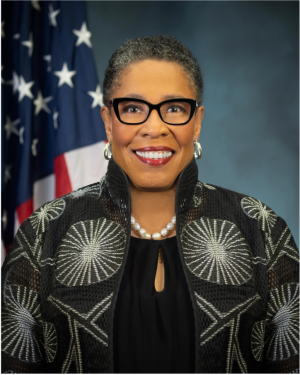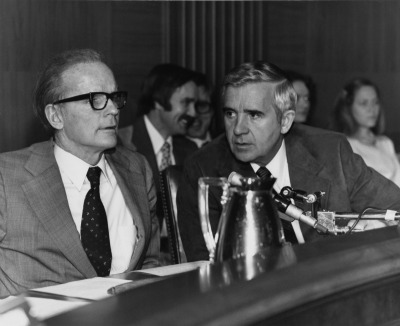
Redlining is a five-alarm word in the lexicon of American racism, but it really has a quite specific definition: The denying of credit in non-white, particularly Black neighborhoods.
The federal government was for redlining before it was against it, instituting color-coded maps of fast-changing metropolises for the better part of the 20th Century. And redlining is very much still around.
How much? The racial homeownership gap is now wider than it was in 1890.
What is not widely known is the role federal banking regulators play in letting this practice continue.
The main law policing redlining is the 1977 Community Reinvestment Act, or CRA. These bank regulators only enforce the CRA when banks seek a merger or acquisition. The broadly written 1960 Bank Merger Act, which President Joe Biden’s administration wants strengthened, also requires banking regulators to consider a merger’s impact on the community.
But the federal government’s merger review process is, at the end of the day, a formality, if a sometimes time intensive and messy formality. The three agencies in charge of such reviews — the Federal Reserve, the Federal Deposit Insurance Corporation and the Office of the Comptroller of the Currency — have not denied a single bank merger in 15 years.
And if these agencies were to find that a merger ran counter to public interest because of a bank’s discriminatory lending practices, it’s not likely anyone would know about it. Like the waitstaff at a country club to a patron whose card was declined, regulators alert banks, often in phone conversations, of the potential for a denial, well before any public exposure.
Banks then quietly withdraw their application, rather than face a public denial.
Ostensibly, the Biden administration has reversed decades-long executive branch indifference to the CRA. Senior administration officials claim that rooting out “modern-day redlining” is a top priority.
In a joint news conference last September, officials at the Consumer Financial Protection Bureau, the Department of Justice and the OCC proclaimed a crack down on “digital redlining.” And in a March interview with former president Bill Clinton, Department of Housing and Urban Development Sec. Marcia Fudge, called attention to the continued practice of redlining.
“We still have redlining in this country,” Fudge said. “We are looking at where we have failed with the CRA, and we know we have.”

DOJ and CFPB can bring lawsuits against alleged housing discrimination. And HUD can bring lawsuits claiming bias in mortgage lending. These agencies, though, do not have a seat at the table when banks, during a CRA exam or undergoing a merger review, provide a voluminous account of their lending practices.
They cannot, in other words, do what the Federal Reserve, OCC and FDIC can do: Compel depositories to catch up to nonbank lenders in their minority loan practice. Indeed, depositories’ mortgage lending to minorities is far behind that of nonbanks, a cruel irony since nonbanks do not have community reinvestment obligations. With bank regulators reluctant to wield their power, community groups often take up the mantle, but with mixed results.
Such inaction is of great frustration to fair lending advocates and also longtime experts on the issue, like Calvin Bradford, one of CRA’s original authors.
“It’s white, male and fairly racist all the way through. There haven’t been women involved in high levels of the [banking] agencies, and no minorities, until fairly recently,” said Bradford, presently the principal of Calvin Bradford & Associates Ltd. “It’s been a racist part of the government that doesn’t care, because its view was: if you’re going to make safe loans, you should make them to white people.”
The CRA, then and now
For more than half a century, the federal government has been officially trying to atone for its role in redlining, which by one estimate cost minority communities $156 billion in equity. Congress passed the Community Reinvestment Act 45 years ago amid public outrage that discrimination in lending had endured, even after enactment of the 1968 Fair Housing Act.
But there was a catch. Nowhere in CRA is there mention of race. This is in contrast to The Fair Housing Act, which directs banks to both not discriminate and further housing opportunities to groups who faced historic prejudice.
Instead, the law required federal agencies to assign banks one of four grades based on the curve of how the bank’s lending to low- and moderate-income borrowers compared to their peers. The law also required banks to lend within their communities. In other words, a bank based in Philadelphia, where the plurality of the population is Black, should invariably lend to Black borrowers.

Fast forward to today, and there are questions about whether CRA gave precise enough guideposts. For example, researchers at the Urban Institute found that low and moderate-income is a poor proxy for people of color.
The law’s ambiguity on some matters may have been deliberate.
“[Dem. Sen. William Proxmire] was good at counting votes, and this just squeaked through,” said Bradford, of the then-chair of the Senate Banking Committee. “He knew it wouldn’t if we put race in.”
“As a politician, he was right,” Bradford said. “But communities were right that not putting it in allowed people to find this escape valve of low and moderate-income.”
Perhaps as a result of this race-neutral stance, even banks that the DOJ accused of redlining pass their CRA exams.
“For banks that have a satisfactory CRA score, it’s still possible for those same institutions to face public scrutiny for redlining actions,” said Jason Keller, a CRA consultant at Wolters Kluwer who previously spent 20 years at the Federal Reserve Bank of Chicago.
Trustmark Bank, for example, settled charges of redlining in the Memphis area for $5 million with the DOJ, the CFPB and the OCC in 2021. But Trustmark has twice received an “outstanding” grade, and five more times a satisfactory grade.
Federal government lawyers assailed Trustmark for redlining in Hispanic and Black neighborhoods. Although half of Memphis’ census tracts are majority-minority, Trustmark did not assign a single mortgage loan officer to any of its branches in those areas, the federal government said.
KleinBank settled with the DOJ in 2018 over allegations of redlining. But the Minnesota-based lender received a satisfactory grade on its CRA exams in each of the four preceding exam years. And, months after the settlement, banking regulators approved Old National Bank’s purchase of Klein.
Old National itself was sued by a fair housing group for redlining in 2021. But that did not stop the Federal Reserve from approving Old National’s acquisition of First Midwest Bancorp in January.

Overall, consumer reviews of Lyft drivers have more critical feedback than CRA exams.
In 2021, two banks received a grade of substantial non-compliance. Eleven banks received the grade of “needs to improve.”
The rest — 358 banks in all — were handed grades of satisfactory or outstanding. In the past 30 years, out of nearly 80,000 CRA examinations reported by the Federal Financial Institutions Exam Council, fewer than 250 banks received a grade of substantially noncompliant. That’s .3%.
“It’s the opposite of the fox guarding the hen house — the rooster is in charge of the hen house,” Bradford said. “[Banking agencies] do not want to deal with discrimination, partly because if you say discrimination, you create liability to make people whole.”
This state of affairs has irked not just advocates of fair lending but other federal agencies that touch redlining. According to a report earlier this month from Inside Mortgage Finance, DOJ has taken to launching more redlining investigations without the prompting of the FDIC, OCC or the Federal Reserve.
Meanwhile, depositories greatly lag non-bank mortgage lenders and credit unions – who are not subject to the CRA – when it comes to minority lending.
A February report by the Urban Institute found that, in 2018 to 2019, banks made 23% of their owner-occupant home purchase mortgage loans to borrowers of color, compared to 31% made by nonbanks. And a Bloomberg investigation found that Wells Fargo, the largest depository mortgage lender in America, approved fewer than half of Black homeowners’ refinancing applications in 2020.

Banks, the Urban Institute’s Linna Zhu, Laurie Goodman, and Jun Zhu argue, became more risk-averse following the Great Recession. They also are originating fewer mortgages overall, and when originating federally-backed mortgages, lending proportionately less to borrowers of color than non-banks.
“Many banks exhibit their risk aversion by imposing underwriting overlays,” per the Urban Institute authors, “That narrows the Federal Housing Administration and government-sponsored enterprises’ credit boxes and makes it more difficult for borrowers without pristine credit to secure a loan.”
Who watches the watchmen?
Months ahead of a 2015 merger between Goldman Sachs and GE Capital Bank, counsel for Goldman Sachs asked top Federal Reserve officials for feedback, documents obtained by a public records request and reviewed by HousingWire show.
These officials include Michael Hsu, then the deputy associate director of the Federal Reserve’s banking supervision and regulation division and now interim head of the OCC, and Scott Alvarez, then the Federal Reserve’s general counsel.
Before any public announcement of the potential merger was made, Goldman Sachs officials and Federal Reserve staff exchanged more than 100 emails, met in person at least once, and had numerous calls, sometimes on weekends, to discuss the upcoming deal.
When a news story broke ahead of the announcement, Goldman Sachs officials discussed the matter with their regulator.
Goldman Sachs gave Federal Reserve officials a powerpoint presentation on the merger. After consulting with the Federal Reserve, Goldman Sachs decided to delay the merger announcement by several weeks. The emails show that Federal Reserve officials were on an informal, first-name basis with the investment bank’s lawyers, and addressed Rodgin Cohen — an attorney at Sullivan & Cromwell — by his nickname, Rodge.
Goldman Sachs and Sullivan & Cromwell did not return requests for comment.
Government watchdogs, policymakers and legal scholars have all sounded the alarm over whether banking regulators act in the interest of the public, or the industry they regulate.

A 2019 report by the Government Accountability Office, the independent auditing arm of Congress, found numerous weaknesses in OCC’s public service. Back in 2017, GAO, in another critical audit, recommended that the Federal Reserve collect employment data to effectively counteract the revolving door between banks and their regulator. The central bank has not done that.
Another factor is what motivates bank regulators. Yes, regulators are legally obliged to assess CRA adherence. But their job – and arguably reputations – hinges on preventing bank collapses.
“In the end, if a bank goes under, no one is going to praise regulators for having held them to a high CRA standard,” said Mark Willis, who spent 19 years overseeing the community development program at JPMorgan Chase.
The Federal Reserve’s funding structure is another clear-cut connection to the banking industry. The agency does not receive appropriations from Congress. Instead, it relies on fees from its investments, and fees from the services it provides to banks.
All excess income from those fees go to the U.S. Treasury. Thus, to do well, the Federal Reserve depends on banks doing well, too.
The Federal Reserve’s structure, which is intended to limit political interference that would disrupt its mission, may also limit disruptions to the financial institutions it regulates. David Dworkin, a former U.S. Treasury official and State Department veteran during the twilight of the Cold War, compared the Federal Reserve Board to the Soviet Politburo.
“A small group of independently powerful leaders who have risen through the ranks defers to a powerful chairman until they don’t,” said Dworkin, now president and CEO of The National Housing Conference, a D.C. nonprofit.
The Soviet Premier — the Fed Chair, in this metaphor — had enormous power. But he depended on maintaining strong support among the party bosses.
“Nearly all of that drama occurred behind the scenes, prompting an entire industry of ‘Kremlinologists’ who tried to figure out what happened in the inner sanctum of the Politburo,” said Dworkin. “Anyone who tries to predict the actions of the Fed today will find that quite familiar.”
Federal Reserve Board chairs, meanwhile, draw power from their relationships with the presidents of the regional Federal Reserve Banks, Dworkin noted.
Their boards are majority elected by representatives from banks.
Business expense
In January, the CEO of Indiana’s second largest bank, which had settled charges of redlining with the DOJ in 2019, assured investors that an upcoming acquisition would sail through regulatory review.
The reason? Instead of balking at the latest consolidation in the world of housing finance, community groups with a particular interest in advancing minority homeownership cheered the move.
Mark Hardwick, CEO of First Merchants Bank, bragged on an earnings call that he was “setting an example” of how to work with community groups, and it was already paying off. One such group, the National Minority Community Reinvestment Co-Operative, which bills itself as a coalition of organizations “committed to addressing the socio-economic needs of minority communities,” had written to federal regulators in support of its December 2021 application to acquire Level One Bancorp.
“Al Pina, who leads the NMCRC, for the first time in his career endorsed a merger,” said Hardwick on a company earnings call in January.
Six months prior, opposition from Pina and other groups to a different bank merger had resulted in a $40 billion community benefits agreement. But the group voiced no such opposition to the First Merchants merger, for reasons that are unclear. (The NMCRC did not respond to requests for comment, and First Merchants declined to comment.)
Less than three months after it had applied for regulatory approval, the Chicago Federal Reserve and the FDIC gave their blessing, the bank told investors in February. Terry McEvoy, managing director at Stephens, who provides investors analysis of First Merchants, said that bank investors are taking more notice of community groups of late.
“Something has changed,” said McEvoy. “Will we get to a point where a specific bank merger is not approved because of this issue? I’m not sure. To date, we’ve only seen delays.”
Community groups often seize on the review process to negotiate concessions from banks. In numerous recent cases, they have accused banks of redlining, sometimes in the form of a lawsuit.
They have had some success. In the past year, community group opposition to mergers cost banks more than $100 billion dollars in community benefits agreements, according to an analysis of Home Mortgage Disclosure Act data. Top-10 mortgage lender US Bancorp, whose merger with MUFG Union Bank is now before the Federal Reserve, is currently in talks for a $100 billion, five-year community benefits agreement.
But none of the community groups’ efforts have yet killed a merger.
Take the case of WSFS Financial Corporation, a Delaware-based bank that sought to acquire Pennsylvania-based Bryn Mawr Bank Corporation.
Groups including the National Community Reinvestment Coalition, a Washington, D.C.-based nonprofit that has negotiated some of the largest agreements in recent years, accused WSFS of being behind its peers in minority mortgage lending.
In Philadelphia, public mortgage data showed 26% of all mortgages went to people of color. But only 13% of those WSFS originated went to people of color, NCRC wrote to the Federal Reserve and the OCC.

However, WSFS, during the same time period and in the same geographic area, received an “Outstanding” on its most recent CRA examination — the highest possible assessment.
“The bank demonstrated good geographic and borrower distribution of loans and excellent lending activity,” the OCC wrote in its 2020 CRA exam. It added that WSFS’ community development lending contributed to the outstanding rating, and it praised the bank for using “innovative and flexible lending products effectively.”
OCC regulators also wrote that they did not identify “discriminatory or other illegal credit practices that require consideration” for the CRA exam.
Rave reviews aside, WSFS did have to answer to NCRC’s assertions. To clear its name, the bank’s lawyers wrote to the Federal Reserve that NCRC’s “insinuation of poor lending performance to minority and LMI communities is unfounded.”
WSFS didn’t deny it trailed its peers in lending to Black borrowers in the Philadelphia area. But it took issue with just how behind it was. In 2018 and 2019, it lagged other lenders in the area by only 3.82% by dollar volume, and 5.85% by number of loans originated to Black borrowers, significantly less than the NCRC’s claimed disparity.
WSFS wrote that it originated 138 mortgage loans – worth about $19 million – to Black borrowers, out of its total 3,609 mortgage loans, or about $765 million by volume in 2018 and 2019.
The difference in its minority borrowing compared to its peers, the bank argued, was because it had fewer minority applicants.
WSFS did not respond to a request to comment.
This back-and-forth has played out numerous times in recent years.
Each year, the Federal Reserve, in reports to Congress, provides statistics on its merger review activity. Its latest, in 2021, showed that while only 3% of mergers receive adverse comments, those that do face an additional 168 days of review, on average. But none of those reviews lead to a scotched merger.
“The fact that the bank responds … means almost nothing to us,” said Kevin Stein, deputy director of the California Reinvestment Coalition. “Conceptually it’s a good thing. But it’s not like we can’t wait to see what they say.”
Reboot the CRA
Banking regulators are aware that redlining is festering, they say, and are working on it.
“We are evaluating how public comments are addressed, including any allegations of redlining, as part of the OCC’s current comprehensive review of the Bank Merger Act,” an OCC spokesperson said.

“The FDIC takes allegations of redlining or other fair lending concerns very seriously during our review and analysis of any merger application,” an FDIC spokesperson wrote. “As a general matter, a finding of a pattern and practice of illegal discrimination is inconsistent with a determination that the application meets the convenience and needs of the community.”
The Federal Reserve declined to comment.
In July 2021, President Biden issued an executive order asking banking regulatory agencies and the DOJ to make a plan for the “revitalization of merger oversight.” The order drew attention to the toll shuttering 10,000 banks over the past four decades took on minority communities, closures partly due to mergers and acquisitions.
CFPB Director Rohit Chopra and FDIC Acting Chair Martin Gruenberg, then member of the FDIC Board of Directors (of which Chopra is a member), sought public input on bank mergers in December 2021. The two questioned whether a CRA grade of satisfactory is a sufficiently high standard for a merger approval, and even suggested CFPB personnel be formally consulted during a merger review.
FDIC chairwoman Jelena McWilliams, though, found the seeking of public input on bank mergers too rash a move. McWilliams was overruled in her opposition to public comment, and subsequently resigned.
At the same time, CRA may finally directly address race. An advanced notice of public rulemaking, spearheaded by Federal Reserve Governor Lael Brainard in October 2020, included a pointed question on racial inequality.
“In considering how the CRA’s history and purpose relate to the nation’s current challenges,” the notice read, “What modifications and approaches would strengthen CRA regulatory implementation in addressing ongoing systemic inequity in credit access for minority individuals and communities?”
Brainard said the notice would “build a foundation for the banking agencies to converge on a consistent approach that has broad support.” Brainard’s notice, in turn, gave mortgage lenders clarity and predictability, according to trade associations representing them.
But the notice also came amid squabbles among banking agencies over CRA revision. In 2019, the FDIC and the OCC proposed its own revised CRA rule, under the leadership of then-Comptroller Joseph Otting, but without the support of the Federal Reserve.
Brainard sharply criticized the proposed rule. She said it was “more important to get the reforms done right than to do them quickly.”
(Brainard is consistent in her deliberate approach. There has not been an update issued on Brainard’s 18-month-old advanced notice.)
According to Hsu, the acting OCC comptroller, “in the not-too-distant future,” federal banking agencies will take the iterative but significant step of a joint CRA notice of proposed rulemaking.
“It will reflect the herculean efforts of staff from all three banking agencies, who have been working around the clock for months, building off each of their many years of practical experience with the CRA and thinking about how to make it better,” Hsu said.
Something’s better than nothing
Few community groups have the firepower of NCRC, which brought in nearly $40 million in revenue in 2020, in part from renting out two office buildings in downtown Washington, D.C..
But NCRC acknowledges it can only make a limited mark on combating lending discrimination. One challenge: The terms of the community benefit agreements obtained from banks are frequently not public.

“The system lacks any means for enforcing the agreements, most of which are obscured from the public, leading to questions of whether banks are holding up their ends of the deals,” the St. Louis Business Journal reported.
“What we’ve always argued is that these community benefits agreements should be bigger than they are, but we are constrained by the regulatory landscape,” said Jesse Van Tol, CEO of NCRC. “Look, what the bank regulators have done has been bullshit, but I wouldn’t want them to take over and say, ‘We know what the community needs are.’”
But for NCRC, a flawed community benefits agreement is better than none at all.
Let’s return to Delaware. WSFS refused to meet with the NCRC to negotiate, the community group said. Despite their opposition, the Federal Reserve unanimously approved the WSFS merger eight months after its application. There were no public conditions for the approval, and no community benefits agreement. One factor in the application sailing through was the bank’s outstanding CRA rating.
It was WSFS’s ninth acquisition in 10 years.
Horacio Mendez, a former banker who is now CEO of the Woodstock Institute, an affordable housing advocacy group in Chicago, is waiting to see if the CRA is strengthened to mention race. But Mendez wonders if even efforts within government to strengthen the anti-redlining law’s teeth matter – whether the OCC, FDIC, and Federal Reserve civil servants who review bank mergers “take this seriously at all.”
“It’s been my experience during the last CRA reform process that the agencies do not see themselves as social justice warriors,” Mendez said. “They see their role as being the guardians of the safety and soundness of the financial system. By both word and action, it’s been clear that making the financial system work for everyone is a side project.”




